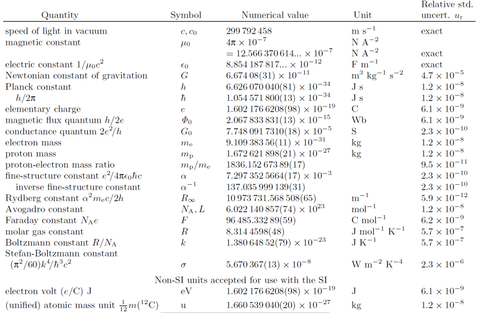
An abbreviated list of the CODATA recommended values of the fundamental constants of physics and chemistry.
In a world of incessant change, some things have to stay the same. One is the set of values for the fundamental physical constants – such as the speed of light or the charge of the electron – that underlie precision measurements in industry, science, and medicine worldwide.
Yet even the constants themselves occasionally change incrementally to reflect the latest experimental determinations. So by international agreement,* a new set of official suggested values is published every four years, and NIST is now displaying the most recent (the 2014 values, published a few weeks ago) on its website.
The quadrennial list rarely generates headlines, but the 2014 values are remarkable in the context of the planned redefinition of the SI base units in 2018.
Several years ago, the international General Conference on Weights and Measures (CGPM) – the diplomatic body that has the authority under the Meter Convention to enact such a sweeping change – approved a plan to redefine four of the seven SI base units** in terms of fixed values of fundamental constants. Those values would be fixed at the most accurate values obtainable at the time of redefinition.
But CGPM placed strict preconditions and technical requirements for agreement and uncertainties in those measurements, and the 2010 values of two key constants did not meet those criteria. For example, CGPM had called for determinations of the Planck constant (h, used to redefine the kilogram) that had relative uncertainties of 20 parts per billion (ppb) and were consistent between two physically different methods of measurement. The 2010 value had a relative uncertainty of 43 ppb.
Thanks in large measure to painstaking efforts by scientists in NIST's Physical Measurement Laboratory (PML) to investigate, reanalyze, and refit NIST's workhorse watt balance, the latest values for h have a combined relative uncertainty of 12 parts ppb – a three-fold improvement since the 2010 values – and are consistent among three different laboratories in three countries. The 2014 values also include a determination for the Boltzmann constant (used to define the kelvin) that substantially exceeds CGPM's relative uncertainty criteria.
Other highlights of the 2014 values include a ten-fold improvement in the uncertainty in the mass of the electron, and significant improvement in the magnetic moment of the proton.
"The 2014 CODATA recommended values of the constants reflect improvements in measurements that allow the redefinition of the SI anticipated for 2018 to be on track," says Peter Mohr, Manager of the Fundamental Constants Data Center in PML. "If things go as planned, this will be the last official set of fundamental constants based on the SI as it is now defined. After 2018 there will be new recommended values based on the new SI that will have significantly smaller uncertainties in most cases."
* The values are determined and issued by the Task Group on Fundamental Constants of the International Council for Science's Committee on Data for Science and Technology (CODATA), which collects the best determinations from academic laboratories, independent standards laboratories, and national metrology institutes. The United States is one of 23 member nations.
** The kilogram, kelvin, ampere, and mole will be redefined in terms of the Planck constant, the Boltzmann constant, the charge of the electron, and the Avogadro constant.

